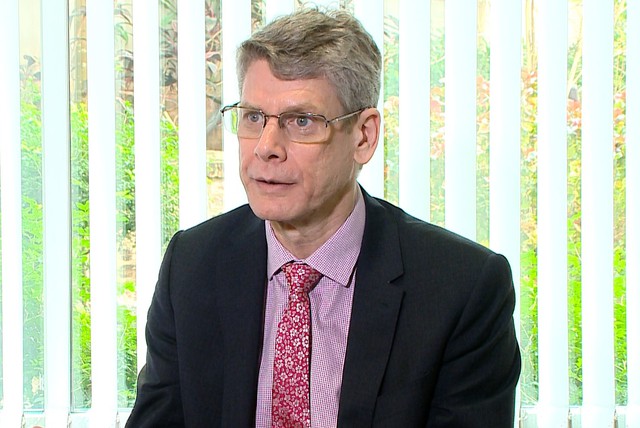Viet Nam’s fundamentals remain strong in 2025: Fulbright University Professor
VGP - Viet Nam’s fundamentals remain strong, and there is considerabe growth potential in the assembly testing and packaging of semiconductors with the rise in global chip demand, noted Dr. Jonathan R. Pincus from Fulbright University Viet Nam.

Dr. Jonathan R. Pincus - Photo: VGP
In a recent interview with VGP, the Fulbright University Professor said, Viet Nam achieved GDP growth of 7.1 percent in 2024, easily exceeding the projections of 6.2-6.5 percent for the year. This was an excellent performance, driven by exports and large inflows of foreign direct investment.
The government has set an ambitious target for 2025 of 8 percent, hoping to build on the momentum from last year. However, the current consensus among domestic and international economists sees growth of around 6.5 percent owing to several potential headwinds that could result in a slowdown from last year.
Export demand is the main challenge. Slower U.S. economic growth would act as a brake on the export boom that Viet Nam enjoyed in 2024. The pace of growth was likely to slow in any case, as restocking inventories represented a significant portion of U.S. imports last year. Moreover, some exports were "pulled forward" into 2024 in anticipation of possible tariffs imposed by the incoming Trump administration.
The economist said, FDI flows are still a key driver of export growth, and this is likely to continue for the foreseeable future.
"Viet Nam could benefit from redirection of trade from China and Mexico to the U.S., as these countries are hit with higher tariffs. Even if the U.S. imposes tariffs on Viet Nam, as long as these are lower than those levied on Chinese and Mexican exports Viet Nam will benefit", Prof. Pincus emphasized.
Aside from exports, infrastructure spending will be another important factor. As Viet Nam integrates into East Asian production systems, money will need to spent on transportation, logistics, renewable energy and digitalization. A big investment push would increase growth potential and support productivity growth.
Domestic demand growth has been weak since the pandemic, as households struggle to reduce debt and build up savings lost during that period. Weak household balance sheets also hold back the recovery of the property sector, which is still reeling from the impact of the banking and capital markets scandal of 2022. Property development companies are still highly leveraged, which is holding back investment recovery.
Key economic drivers anticipated for Viet Nam in 2025
According to the Fulbright University Professor, export manufacturing is still the key driver of Viet Nam's economy in 2025, especially in electronics, machinery and textiles. Exports by FDI firms account for 75 percent of all exports, and the ongoing FDI surge should support export growth in 2025. Viet Nam will benefit from trade reallocation as U.S. and other countries reduce sourcing from China, and Chinese companies diversify into Viet Nam.
Infrastructure spending will also drive growth. The government plans to complete another 1,000 km of highways and undertake other investments to improve connectivity, including the new airport in Ho Chi Minh City and expansion of the Ha Noi airport. Plans to develop high-speed rail lines could boost infrastructure spending. Maintaining high disbursement rates of public investment, and prioritizing economically important projects, will be key policy goals.
The government has also announced steps to stimulate the real estate market through policies such as expediting the approvals process, legal reforms under the new Land Law to reduce uncertainty and expansion of the supply of land available for development. More accommodative monetary policy would help stimulate the sector, but only if inflation pressures do not reemerge.
Intertwined opportunities, challenges for Viet Nam's economy in 2025
Dr. Pincus held that Viet Nam is one of the world's top locations for assembly operations in electronics, machinery and textiles. FDI into these industries has created millions of jobs generated the foreign exchange that Viet Nam needs to import essential goods and technology.
The expected spillover effect from assembly operations to domestic firms has never materialized. Viet Nam's exports are the most import-intensive in the region, meaning that more than half of the value of all exports is spent on imports. In some industries, for example mobile phones, this figure is as high as 85 percent. FDI firms still account for 75 percent of all exports, which is both an indication of Viet Nam's success in attracting foreign investment and the weak export capacity of domestic firms.
Spillover effects are not automatic. Foreign firms have no real incentive to localize domestic production of inputs. The history of other East Asian countries suggests that the presence of domestic companies of a sufficient scale, and with sufficient capacity to acquire technology from foreign companies, is an important factor.
Viet Nam's industrial structure is still characterized by a "missing middle," consisting of few large companies and millions of micro-businesses. Even large companies are largely inward oriented, earning money in properties, finance and retailing. What is missing from this picture are medium-to large-scale manufacturing companies that focus on exports.
Viet Nam spends relatively small amounts of money on higher education and research and development. There has been an expectation that the universities, both in the public and private sector, should be self-funding. This has held back progress, as the universities cannot afford to hire the best talent or build laboratories to attract world-class researchers. A weak university and research sector has held back domestic firms for many years.
Climate change is another major challenge. As a coastal country with two large delta regions, Viet Nam is one of the most vulnerable countries in the world to sea level rise and extreme weather events. Adapting to climate change will require increased investment in infrastructure, social housing and training as millions of workers relocate and look for jobs.
The Mekong Delta will be particularly hard hit, as the effects of climate change are made worse by upstream dams, sand mining and groundwater extraction. Managing the flow of migrants out of the delta, and managing the transition from intensive rice cultivation to production of higher value-added commodities will be important.
The transition to renewable energy is both an opportunity and a risk, noted the economist, adding that it is an opportunity as Viet Nam has vast wind and solar resources that could be used to power its manufacturing, burnishing the country's credentials as a major center of green production.
Demand growth could also stimulate production of solar panels, wind turbines and other machinery and equipment, both for domestic consumption and export. The energy transition is also a risk, as importers like the European Union will progressively impose trade restrictions on goods produced with nonrenewable energy. Delays in moving from coal to wind and solar could have a negative effect on Viet Nam's exports./.
Dr. Jonathan R. Pincus was former UNDP Senior International Economist and is currently Dean of Fulbright School of Public Policy and Management, Lecturer, Fulbright School of Public Policy and Management, Fulbright University Viet Nam.

